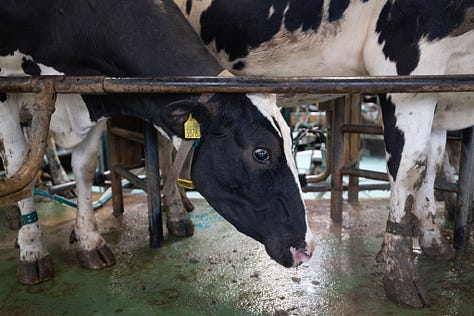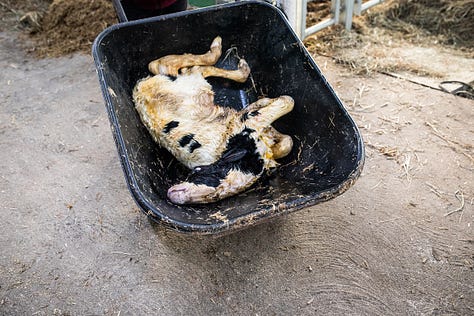A Shocking Number of People Still Think Cows Produce Milk Just Because They’re Cows
I’m not judging — I believed it too.
I’ve spent years researching the dairy industry and talking to people from all walks of life — from university professors to supermarket cashiers, from chefs to farm workers. And what continues to shock me is how many people, even highly educated ones, still don’t understand one fundamental fact: cows don’t give milk because they’re cows.
I’ve heard this misconception everywhere — in outreach conversations, in casual chats, even from someone working in a dairy plant, who genuinely believed cows just naturally produce milk all the time — and that by milking them, we’re actually doing them a favor. A UK survey found that 52% of the public was unaware that “cows are impregnated annually to enable milk production.”
And there’s no judgment here. I used to be one of them. Looking back, it feels almost surreal. I thought of myself as a curious, thoughtful person, yet I never once questioned how something I consumed every day was actually made. But once you do, it changes everything: how you see milk, how you think about cows, and how you relate to an entire system most of us have never really looked at.
10 Things Everyone Should Know About Dairy
1) Milk begins with forced pregnancy
Cows don’t just make milk — like humans, they have to be pregnant first. In the dairy industry, this happens as early as the animal’s puberty — sometimes when they’re barely over a year old. It’s a deeply invasive process, often involving a farmer inserting an arm into the cow’s rectum while guiding a metal rod into her vagina. The cow is typically restrained in a device grimly referred to as a “rape rack.”
2) Motherhood is met with trauma
After carrying their calf for nine months — just like a human mother — the cow gives birth. But the joy of birth is immediately followed by heartbreak. The newborn is taken away within hours or days, a wrenching separation that often causes the mother to cry out in distress for days. And this isn’t a one-time event. In order to keep milk production going, dairy cows are kept on a cycle of repeated pregnancies — usually one per year — which is physically and emotionally taxing for the animals.
3) Calves are mutilated or killed
Male calves are useless to the dairy industry. Many of them are shot shortly after birth. Others are sold for veal, confined in crates, and slaughtered as infants. They are often mutilated: castrated and dehorned without anesthesia. These procedures are excruciating — horns, for example, are connected to hypersensitive nerve tissue, but are burned or gouged out nonetheless.
4) Cows are pushed beyond nature’s limits
To maximize profit, dairy cows are forced to produce up to 10 times more milk than they would naturally. A cow’s udder, which is biologically designed to hold a manageable amount of milk for one calf, becomes grotesquely swollen under industrial demands. These overfilled, distended udders can become heavy, stretched, and painful, making it difficult for cows to walk or even lie down comfortably.
5) There is often pus in cow’s milk
The unnatural level of milk production leads to frequent cases of mastitis, a painful udder infection so common that pus often ends up in the milk supply. Yes — there is legally allowed pus in the milk you drink.
6) Cows are treated like machines until they collapse
After a few years of forced pregnancies, births, milkings, and separations, a cow’s body begins to fail. Many become so exhausted that they collapse and are no longer able to stand. Industry workers call these “downer cows.” Whether they’re still walking or not, nearly all are sent to slaughter — usually around 4 to 5 years old, even though their natural lifespan could be 20+ years.
7) Violence is not the exception — it’s the norm
While routine practices are already cruel, investigations continue to uncover extreme acts of violence on dairy farms: cows being beaten, kicked, whipped, stabbed, burned, hung by machinery, dragged across concrete, or drowned in pools of excrement. This isn’t rare — it’s systemic.
8) Dairy is an environmental disaster
Dairy production is a major driver of deforestation and water pollution. It requires massive amounts of land, feed, and water, and generates significant methane emissions — a highly potent greenhouse gas. The climate impact of just 13 dairy firms is equivalent to that of the entire United Kingdom. For comparison, oat milk uses about 90% less land and freshwater and produces 70% fewer greenhouse gas emissions than cow’s milk. Experts say that avoiding dairy and meat is the “single biggest way to reduce your impact on Earth”.
9) Dairy is not essential for health — quite the contrary
Despite generations of marketing claiming milk is essential for strong bones and healthy growth, nutrition science tells a different story. Many populations thrive without dairy, and diets free of cow’s milk are often associated with lower risks of acne, diabetes, certain cancers, and heart disease. Simply put: humans don’t need cow’s milk any more than they need giraffe’s milk, rat’s milk, or dog’s milk.
10) We’ve been lied to
The dairy industry has spent decades crafting a narrative: happy cows, wholesome farms, essential nutrition. But it’s a story built on omission and outright deception. From childhood, we’re conditioned to see milk as a symbol of purity — not as the product of forced reproduction, stolen motherhood, and industrial violence.



This won’t change without people like you
In recent years, awareness about the realities of dairy production has grown — thanks to viral memes, award-winning documentaries, and even celebrities like Joaquin Phoenix, who used his Oscar speech to speak out against the cruelties of the dairy industry.
Yet, too many people are still unaware that cow’s milk comes from pregnant, birthing, lactating mothers — gentle beings who were separated from their own mothers, then from their babies, mutilated, and sexually abused, time and time again, until they eventually break down and are slaughtered, all for a product that humans don't even need.
To help raise awareness — and push back against the dairy industry’s misinformation — I kindly ask you to share this article with your networks, and consider forwarding it to anyone who might resonate with the message or benefit from learning these crucial facts.
Vegan Horizon is a reader-supported publication. To receive new posts and support my work, consider becoming a free or paid subscriber.






I knew from a young age that cows needed to be impregnated to make milk. I witnessed an insemination firsthand at the young age of 11, as part of a school project. I also watched the birth of that calf and saw her sent away to slaughter and served up for lunch to our class one year later. I'm completely serious. They fed us her flesh! I ate a bite!
I spent my entire adolescence on two different small dairy farms, working with the cows and calves, noticing them often disappear without a word. I learned how to milk them manually and with machines. I spent a day with a friend at a 400 cow farm where she was working some 4H-style program and saw with my own eyes several of the things you mention here: cows wallowing knee deep in their own waste, sick newborn calves languishing and being left to die, tiny babies in tiny hutches, a recordbook in the office of each cow and their fate (the oldest was 6 before being sold).
And even though I found all of it pretty disgusting up close, I still didn't become vegan until age 31, having been very far removed from that environment for nearly 15 years.
I mention this mostly to speak to the power of social conditioning. Even when we do know, it can take a very long time to put the pieces together without some outside agitation. That's partly why I believe the movement's greatest opportunity is simply to become so visible and omnipresent that our message is impossible to ignore. Because when you're forced to see and think about these things, it becomes much harder to put it at the back of your mind for decades like I did.
And despite being forcibly impregnated, the mother loves their baby, and cry when they're taken away😞💔🐮🐄
A system of immense cruelty, built off the exploitation of the female reproductive system😞